Carl E. Olson's Blog, page 67
December 6, 2014
"Behold Your Mother!": Meeting the Virgin Mary in D.C.

Fra Filippo Lippi, Madonna and Child (Madonna col Bambino) (detail), ca. 1466–69; Provincia di Firenze, Palazzo Medici Riccardi, Florence (nmwa.org/exhibitions/picturing-mary-w...)
"Behold Your Mother!": Meeting the Virgin Mary in D.C. | Br. Gabriel Torretta, O.P. | CWR
A new exhibit at The National Museum of Women in the Arts draws together a stunning collection of Renaissance and Baroque artwork
What do you suppose is the one verse of the Bible that has generated the most Christian art?
Certainly John 1:14—“and the Word became flesh”—is a compelling option, as the reality that God became man is the fertile soil from which all artistic praise of God springs. But is there one seed that has fallen into that soil and borne the most fruit? For that honor, I’d suggest a different verse from John, this time towards the end of the Gospel: “Behold your mother!” (Jn 19:27).
Behold your mother! What a tremendous harvest of art, culture, and beauty has sprung up from these three simple words! Almost from the first days when Christians began making representational art, Mary has been a constant presence, the perfect witness through whose eyes the mystery of Christ is revealed in its loving splendor. By the late fourth century, for example, Mary begins to appear next to the Christ-child in Nativity scenes, poised in humble adoration, and what may be the earliest extant crucifixion scene, an ivory carving from around 420, features a stalwart Virgin poignantly framed between Judas the Suicide and John the Beloved Disciple at the side of the Cross.
To tell the story of how Christians have beheld their mother in art through paintings, sculpture, literature, music, and architecture is almost coterminous with telling the story of Western art tout court.
The National Museum of Women in the Arts in Washington, D.C. has spared no expense or effort to capture the depth and radiance of this artistic tradition with its new exhibit, entitled Picturing Mary: Woman, Mother, Idea, running from December 5, 2014, to April 12, 2015. This exhibit of more than sixty paintings, sculptures, and liturgical vestments from the Renaissance and Baroque periods is curated by Msgr. Timothy Verdon, director of the cathedral museum (Museo dell’Opera di Santa Maria del Fiore) in Florence, whose vast artistic erudition and deep Marian devotion is abundantly evident in every detail of this landmark project.
Picturing Mary moves through six distinct exhibit spaces, each concentrating on a specific way of considering the Virgin artistically and theologically:
December 4, 2014
Normality Is Not Hatred
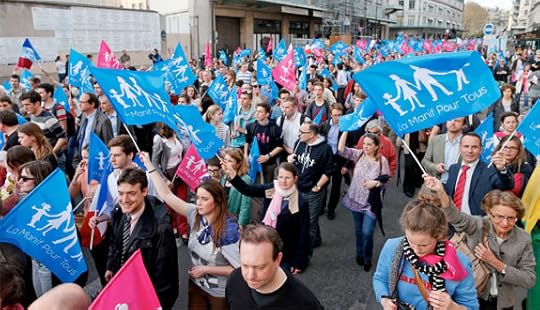
People wave banners as they demonstrate against France's planned legalization of same-sex marriage in Paris in April 17, 2013. (CNS photo/Benoit Tessier, Reuters)
Normality Is Not Hatred | James Kalb | CWR
Today’s politics has no place for legitimate authority based on higher standards, so power must base itself on Choice, otherwise known as the Triumph of the Will
Very recently the view that homosexuality is entirely normal has become not only widespread but compulsory in secular public discussion.
Leaders of thought tell us the change has been part of a general deepening of moral insight and improvement in the art of living. The older outlook oppressed millions out of fear, bigotry, and ignorance. We have learned better now, except for a few haters and dimbulbs who need to be re-educated or else shamed and shut up until death frees the world from their presence.
Many Catholic clergy, theologians, and ordinary believers more or less agree. We have been wrong, and if we don’t get with the program and accept the world’s guidance we’ll become irrelevant and vanish except for a few weirdoes no one sensible would want to associate with.
Such or allied views have led to very high level suggestions that the Church “accept and value” the homosexual orientation and ramp up opposition to “unjust discrimination,” which now seems to include suggestions that there is something wrong with homosexuality. So any statement of the general objection to the orientation, that it is objectively disordered, is now to be out of bounds. Inconsistent doctrine is to be treated as a hangover from the past to be dealt with in such a way as to neutralize it and effectively make it disappear.
To exacerbate the problem, most of those attached to the traditional view have difficulty arguing for it effectively. It seems plainly right to them, but why it is right cannot be stated in the terms on which public discussion is now carried on, which treat equal preference satisfaction as the highest good. The traditional view therefore comes to seem an irrational prejudice.
Still, the issue doesn’t go away. The older view continues to have distinguished proponents, and the vehement reactions to doubters suggests that supporters of the new view are conscious of a certain weakness in their position. Is something being overlooked? Can a sudden and total change of longstanding deeply-rooted understandings be trusted?
The change looks very much like an attempt to invert reality, an effort that once started becomes all-consuming and requires an ever more comprehensive system of lying to maintain. And the demands of correct thought are indeed becoming ever more far-reaching. Insistence that a relationship between two men is a marriage if they say the necessary vows has been followed by insistence that the men immediately become women if they announce they have. And that demand has been accompanied by attempts in the schools and elsewhere to get rid of indications of grammatical gender and other inflammatory expressions when dealing with children.
These supposed advances have been led not by saints and sages but by ideological activists, media propagandists, and other dubious characters. Supporters claim to speak for the “marginalized,” but are preferentially found among the rich, powerful, and well-placed, who evidently speak for themselves and those to whom they feel an affinity.
In that respect the movement is typical of modern politics, which promises liberation but delivers new forms of domination. The problem is basic.
December 3, 2014
Yes, We Can Know Truth Today

Yes, We Can Know Truth Today | Fr. Paul Conner, OP | Homiletic & Pastoral Review
How astonishing it is to be a human person! Like vegetables, it is wonderful enough to be able to assimilate inanimate minerals and grow, as well as to reproduce our own kind. Like our dear pets, it is amazing that we have senses to know the physical world, and emotional and instinctual reactions to that ongoing awareness. We can even move on our own from place to place!
But how much more amazing it is that we can also know and react in a very different way—as persons. We can define what our senses present to us, letting us know and name each thing distinct from every other. We can reflect on the meaning of what happens to us and of the emotions and instincts we experience. From understanding, we can invent, and together create, a culture and civilization. We can express knowledge in language and translate one tongue into another. With language we can joke, entertain, and laugh.
And beyond knowing the physical side of experience, we can ponder and come to understand the vast array of non-physical realities—such as friendship, loyalty, betrayal, courage, cowardice, inspiration, honesty, character, heroism, etc. We can become self-aware and build up self-knowledge throughout a lifetime. But best of all, we can know, converse and cooperate with, and love others as persons. These marvelous things we can do, because to be a person is so much more wonderful than to be a plant or animal.
In addition to knowing as a person, we can freely choose so much beyond the automatic responses of our bodies; we exercise personal freedom daily in matters great and small, a second power unknown to even the biggest, strongest, and most developed of animals.
These two highest powers of being human, which afford the greatest experiences of life, are named intellect and free will.
December 2, 2014
Gorgeous new children’s book tells the Christmas story through the eyes of a shepherd child
Ignatius Press and Magnificat have released a beautiful new children’s book re-telling the Christmas story, as it is seen through the eyes of a shepherd child. This heart-warming new tale, Ishmael: The Shepherd Boy of Bethlehem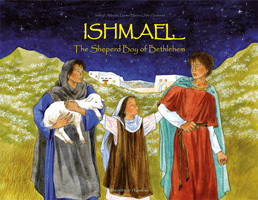 , tells the moving story about an appealing shepherd boy who encounters the baby Jesus.
, tells the moving story about an appealing shepherd boy who encounters the baby Jesus.
Ishmael is a handsome boy of thirteen who knows how to be gentle and kind, but is not afraid of putting up a fight to protect his sheep.
Along with the other shepherds in his family and their flocks, he arrives in Bethlehem. Crowds are pouring into the town to obey the command of Emperor Augustus: he has ordered a census to count all the people in the world. Ishmael is worried. Shepherds are not always welcome in the villages. What would happen in Bethlehem?
Ishmael is about to discover friendship and peace of heart through the birth of Christ. What if all the children of the world were to come and kneel before the baby Jesus, and receive that same deep love and peace?
Ishmael is a beautiful, touching Christmas story about peace and reconciliation, brilliantly illustrated with lovely, colorful pictures throughout the book. It is an ideal Christmas gift for children, one that will inspire them with the love of the baby Jesus as well as teach them an important lesson about kindness and peace.
To request a review copy or an interview with Vivian Dudro, Editor of Ishmael, please contact:
Rose Trabbic, Publicist, Ignatius Press, (239) 867-4180 or rose@ignatius.com
Sample illustrations:

Save 50% on these best-selling and new DVD series, thru Dec. 31st

This Christmas help enrich your loved ones' faith
by gifting them with one of our
inspirational and educational DVD series.
And, as our gift to you, from now until December 31st we're offering 50% OFF on the best-selling
and new DVD series listed below.
Don't miss this opportunity! Order today!
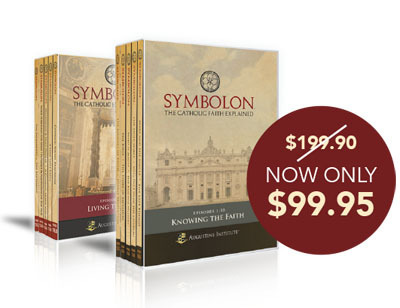
Symbolon: The Catholic Faith Explained
The Complete Set
Symbolon: The Catholic Faith Explained is a stunning new video series that systematically presents the BIG picture of the Catholic Faith. This compelling series contains two parts including ten episodes each. In Part 1 we journey through the core teachings of the Catholic Church traced out in the Creed and Catechism with the goal of knowing the Faith. In Part 2, we focus on our encounter with God in the sacraments and the moral life so that we can be fully living the Faith.
Order Today

YDisciple True Beauty and True Strength DVD Set
The True Beauty and True Strength series focuses on what it takes to be real man or woman of God, as it discusses the themes of chastity, love, fellowship, and relationships in the everyday lives of young men and women.
Order Today
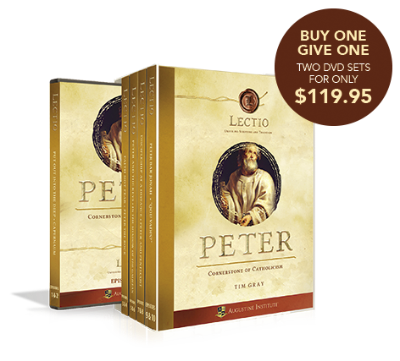
Lectio: Peter
Cornerstone of Catholicism*
Join Dr. Tim Gray — gifted Scripture teacher, internationally acclaimed author, and President of the Augustine Institute — on a Biblical voyage unlike any other. In this first installment of Lectio: Unveiling Scripture and Tradition, Dr. Gray takes us on an intensive journey into the life of one of history’s most compelling characters.
Peter: Cornerstone of Catholicism offers a fascinating, in-depth study series on the life and meaning of St. Peter. Bringing together Biblical stories, historical knowledge, solid Church teaching, and personal insights, Dr. Gray gives a fresh perspective on the fisherman who Jesus entrusted with His Church. In these 10 stirring lectures, we’ll learn what happens when flawed humanity comes up against God made flesh.
* This is available as a presale item that will ship by December 12, 2014.
Pre-order Today






Copyright © 2014 Ignatius Press, All rights reserved.

Share

Tweet

Forward
November 29, 2014
Advent: Expectation, Exhortation, Eucharist, Eternal Life
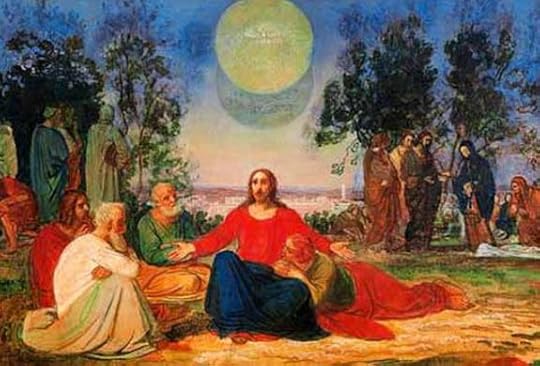
"Preaching of Christ on the Mount of Olives about the second coming" (1840) by Alexander Ivanov (WikiArt.org)
A Scriptural Reflection on the Readings for Sunday, Nov. 30, 2014 | First Sunday of Advent | Carl E. Olson
• Isa 63:16b-17, 19b; 64:2-7
• Psa 80:2-3, 15-16, 18-19
• 1 Cor 1:3-9
• Mk 13:33-37
When the Son of God came the first time, St. Augustine stated in a sermon, “he came in obscurity, it was to be judged. When he comes openly it will be to judge.” This observation is a helpful (and challenging!) bridge between last week’s Gospel reading—the parable of the sheep and the goats—and today’s Gospel reading, proclaimed on this, the first day of the liturgical year.
“Advent” comes from the Latin word adventus, which in turn is a translation of the Greek word, parousia. Both words indicate a coming or arrival and a presence. Advent focuses simultaneously on the first and second comings of Christ, and his presence with us now, especially in the blessed sacrament of the Eucharist. The parousia—sometimes called the second coming of Christ—will be realized fully at the end of time, but has already been initiated by the Incarnation, which revealed the glory of God among men (cf., Jn 1:14).
While some Christians fixate upon the return of Christ to the point that little else matters, Catholics should—especially during Advent—gaze upon and receive the Eucharist, knowing that it is why anything matters at all. In doing so, we proclaim his coming, anticipating the culmination of time and history.
“By gazing on the risen Christ,” wrote Joseph Cardinal Ratzinger, in Eschatology, his book on death and eternal life, “Christianity knew that a most significant coming had already taken place. It no longer proclaimed a pure theology of hope, living from mere expectation of the future, but pointed to a ‘now’ in which the promise had already become present. Such a present was, of course, itself hope, for it bears the future within itself.” (Eschatology, 44-45).
The Son of God transcends past, present, and future. Yet he became man, entering into time and history in the most stunning and unexpected way: in the darkness of a cave. Nearing the end of his earthly ministry, facing death, he exhorted his disciples, “Be watchful! Be alert!” Thus he emphasized that the second coming would also be unexpected and sudden.
These exhortations to vigilance, although mysterious, helped the early Christian to comprehend the deeper meaning of the destruction of the Temple in A.D. 70. They could see that the Church is the new temple, for the Church is the mystical body of Christ. “When he announces its destruction,” the Catechism explains, “it is as a manifestation of his own execution and of the entry into a new age in the history of salvation, when his Body would be the definitive Temple” (par. 593).
Our Lord first came as a humble babe, hidden in a manger, surrounded by family and the shepherds who responded to the glorious news given by angels. He now comes to us in humility, hidden under the form of bread and wine, within the household of God, giving himself to his sheep—those who have responded to the saving message of the Gospel. This gift of the Son is why we can call God our Father. It is also why we acknowledge, as did the prophet Isaiah, our desperate need to be molded and shaped by the loving hands of the Creator: “Yet, O LORD, you are our father; we are the clay and you the potter: we are all the work of your hands.”
Jesus Christ will one day come in again in power and glory, to judge the living and the dead. Every man will face judgment; every deed will be revealed. “Even now,” St. Augustine told his flock, the Savior “does not keep silent, if there is anyone to listen. But it says he will not keep silent then”—at the final judgment—“because his voice will be acknowledged even by those who despise it.”
Those who despise and ignore the words of Christ are asleep, cocooned in spiritual slumber and sloth. Those who are alert and watch are aware of the Lord’s presence. They long for his coming. They place their hope in the Lord. Such is the essence of Advent.
(This "Opening the Word" column originally appeared in the November 30, 2008, edition of Our Sunday Visitor newspaper.)
What Replaces Christianity?

(© Rawpixel/fotolia.com)
What Replaces Christianity? | Fr. James V. Schall, S.J. | CWR
A general outline of what is replacing Christianity as the public order of the old Christendom and its overseas enclaves
We often hear expressions like “the post-Christian era” to describe the time we live in. Just as Christianity preserved many pagan practices, a “post-Christian era” will retain many Christian customs and ideas. They will usually be disguised under different names or explanations. We will notice a pseudo-heaven and hell, an explanation for sin not based on free will, an inner-worldly immortality of sorts, an evil and a good in Manichean fashion.
But a post-Christian age will invent new names and explanations for them. It will logically “develop” ideas into a new form or synthesis that is anything but Christian. To know what a post-Christian era might mean, no doubt, it is helpful to know what Christianity is and maintains. And this knowledge, in spite of the General Catechism, is not easy to come by today. We used to talk of Christian “heresies”. These were explanations of one or other Christian idea in a different, erroneous, or inaccurate way. But the heretic generally did not disagree with the whole corpus of Christian ideas. In fact, he thought he was giving a better explanation of those ideas and beliefs.
What “replaces” Christianity, we can assume, will want to appear to itself, at least, to be logically coherent. It will claim to explain human life and its earthly condition, usually in what is called a “scientific” way. Indeed, that will be one of its basic propositions, namely, that everything can be explained by scientific method. What cannot be so explained will be said not to exist, or not to be worth studying. Scientific method itself depends on quantity and mathematics based on it. If reality also contains things that are not quantifiable, that can be reached by other methods, these facts will be denied or ignored.
What are the most obvious tenets to a world-view that replaces Christianity? I would begin by pointing out that other world-views like Islam, which also intend to replace Christianity, have remained pretty much consistent with themselves over the centuries. It is true that Islam can be considered a New Testament, or better Old Testament heresy. Most of its ideas were present in some form before its arrival on the scene in the seventh century. And Islam is indeed one of the major candidates to replace Christianity in many parts of the world, as it did in the early years of the Muslim conquest of Persia, North Africa, the Holy Land, and across the central Asian plains to parts of India.
One way to look at this issue would be to consult birth-rates among various nations and peoples.
November 28, 2014
Men without roots turn into looters; men without purpose turn into predators

A man walks past a burning building during rioting in Ferguson, Mo., Nov. 24 after a grand jury returned no indictment in the Aug. 9 shooting death of Michael Brown in the St. Louis suburb. (CNS photo/Jim Young, Reuters)
Men without roots turn into looters; men without purpose turn into predators | Carl E. Olson | Catholic World Report
All of the constant talk about "racial tensions" in Ferguson (and other communities) is distracting from the biggest elephant in the family room
"We have heard enough of liberty and the rights of man; it is high time to hear something of the duties of men and the rights of authority." — Orestes Brownson
The term of the week, as the fires burn in Ferguson, is "racial tension." A quick Google news search for that term, coupled with "Ferguson", turns up nearly 10,000 results. Having now read far too many stories about what has transpired in Ferguson over the past few days, I have concluded that while the term "racial tensions" is not without some meaning—however vague—it is quite often more of a rhetorical crutch than a helpful tool for understanding what has (and has not) happened in Missouri and throughout the country.
A CNA piece, "What the Church can do about the powder keg of US racial tensions", for instance, gives extended time to the thoughts of Dr. Norm White, a professor of Criminology and Criminal Justice at St. Louis University. The article states:
Dr. White pointed to two major problems as the source of the uproar in Ferguson: inequality and a law enforcement system where young African-American males feel targeted and are ready to lash out in response.
To combat local crime and gang problems in the early 1990s, he explained, authorities in the area turned to the “broken window” model of policing every minor infraction in order to stop the bigger problems of gang violence.
Without questioning the possiblity or reality of inequality and dubious law enforcement, I am more interested in the question that isn't asked of Dr. White: "Why was there so much local crime and 'gang problems' and 'gang violence'?" What were/are the causes? Why is the rate of property crime in Ferguson about twice (or more) the national average? And does the fact that roughly two-thirds (14,297, as of 2010) of Ferguson's 21,203 citizens are African-American have anything to do with anything?
Unfortunately, questions like that are likely to be deemed racist, because looking into the real roots of violence, gang activity, and related matters must, necessarily, involve looking at the state of the family in predominantly black communities. But doing so, as Jason L. Riley of the Wall Street Journal points out in his November 25th op-ed, "The Other Ferguson Tragedy", doesn't feed and support the usual "anti-police narrative that harms the black poor in the name of helping them." Riley writes:
According to the FBI, homicide is the leading cause of death among young black men, who are 10 times more likely than their white counterparts to be murdered. And while you’d never know it watching MSNBC, the police are not to blame. Blacks are just 13% of the population but responsible for a majority of all murders in the U.S., and more than 90% of black murder victims are killed by other blacks. Liberals like to point out that most whites are killed by other whites, too. That’s true but beside the point given that the white crime rate is so much lower than the black rate.
Blacks commit violent crimes at 7 to 10 times the rate that whites do. The fact that their victims tend to be of the same race suggests that young black men in the ghetto live in danger of being shot by each other, not cops. Nor is this a function of “over-policing” certain neighborhoods to juice black arrest rates. Research has long shown that the rate at which blacks are arrested is nearly identical to the rate at which crime victims identify blacks as their assailants. The police are in these communities because that’s where the emergency calls originate, and they spend much of their time trying to stop residents of the same race from harming one another.
I covered much of the same ground in a July 15, 2013 CWR post about the media furor over the trial of George Zimmerman, writing, "The real issue here is not racism, since most violent crime is intraracial. No, it is actually the culture of death, which is rooted (so to speak) in the collapse of families, the corresponding rise in gangs, the obliteration of basic familial and social responsibilities, and a growing subculture that is, it can be fairly said, barbaric and violent in nature." And:
November 27, 2014
Adding Catholic Color to Monochromatic US History

Adding Catholic Color to Monochromatic US History | Carrie Gress | CWR
An interview with Emily Stimpson, co-author of The American Catholic Almanac
The founding of the United States has a lot more color than the typical Protestant narrative, thanks to the heroics, quirks, and sacrifices of American Catholics. In her new book, The American Catholic Almanac, (Image Books, 2014), Emily Stimpson chronicles the saints and sinners who helped shape America from the founding on.
Stimpson, who has also written The Catholic Girl’s Survival Guide for the Single Yearsand These Beautiful Bones: An Everyday Theology of the Body, spoke with Catholic World Report about the book she co-authored with Brian Burch, president ofCatholicVote.org, and some of the surprising finds buried in the pages of time.
CWR: What prompted you and Brian to write this book?
Emily Stimpson: From the earliest days of America’s founding, a large number of the nation’s Protestants argued that democracy and Catholicism weren’t compatible. Those arguments often turned ugly, with nativist groups such as the Know-Nothings burning churches, convents, and Catholic schools, as well as targeting Catholics in their homes. Catholics worked hard to counter that sort of bigotry and secure a place for themselves in this country. To a large extent they succeeded. Unfortunately, in recent years, anti-Catholicism has begun rearing its head again.
Obviously, no one is burning churches just yet, but the same arguments once made against Catholics—that we shouldn’t have a voice in the public square, that we should keep our faith to ourselves, that our beliefs aren’t compatible with democracy—are being made again. Brian and I thought that one way to counter the hostility towards faith in general and Catholicism in particular was by demonstrating the profound effect Catholics have had on this country. America wouldn’t be America without the contributions of the Catholic men and women we write about in the Almanac. The history of Catholicism in America is our family story, and the better we know that story and the better we appreciate it, the better we can face the challenges coming at the Church today.
CWR: The book has an unusual format—it seems to be an “American Catholic History for Busy People.” Is that what you had in mind, particularly with its one-entry-per-day approach?
Continue reading at www.CatholicWorldReport.com.
November 26, 2014
“There Is No Individual Apart From A Family”: Louis de Bonald's Defense of Marriage

Louis Gabriel Ambroise, Vicomte de Bonald (1754-1840) [Wikipedia.org]
“There Is No Individual Apart From A Family”: Louis de Bonald's Defense of Marriage | Jerry Salyer | CWR blog
The French Catholic philosopher warned that any people which permits the public repudiation of the matrimonial covenant is doomed to become trite, shallow, and silly
“I think that on this question,” writes Louis de Bonald regarding divorce, “the government should concern itself not with religious beliefs, but with reasonable actions.”
Another liberal disguising with smooth talk a ploy to subvert Western civilization’s Christian foundations? Hardly. In fact, the aforementioned French Catholic philosopher was emphasizing a point essential to natural law theory: far from contradicting reason, the Church’s divinely-inspired teachings on controversial topics often lead to conclusions similar to those of clear-headed human reflection. Per Bonald, we should not really need spelled out for us in ten-foot tall letters of revelatory fire the fact that divorce harms children, that it undermines the social fabric, that it is a plague to be combatted rather than a legitimate choice to be endorsed. Trapped in a culture that has forgotten not only the Gospel but common sense to boot, Catholics would do well to acquaint themselves with Bonald's On Divorce.
Born in 1754 to a family of provincial nobility, Viscomte Louis Gabriel Ambroise de Bonald remained always proud to be a native of Rouergue. a hard, rocky region inhabited by self-reliant, pious peasants and characterized by one of Bonald’s biographers as “the Appalachia of France.” A King's Musketeer in his youth and then mayor of his hometown, Bonald was a devoted husband as well as the affectionate father of four.
He was also for some time a wanted man. Once it became clear that the new Jacobin government intended to subordinate and disempower the Church, Bonald’s initial naïve support for the French Revolution turned into fervent opposition, and he was forced to flee his homeland. He joined a counter-revolutionary army; after attempts to dislodge the Jacobins by military means proved futile he slipped back into the country, to Paris, where he lived, studied, and wrote while in hiding. Following the fall of the Jacobins he was pardoned by Napoleon and re-entered public life, and then under the Bourbon monarchy he obtained a seat in the Chamber of Deputies. With that seat came a chance to translate some of his reactionary ideas into policy. Foremost on his agenda was the abolition of divorce.
Upon seizing power the Jacobins had taken great pains to liberalize French marriage laws, declaring the marriage bond soluble; Bonald saw this action as nothing less than a direct assault upon civilization as such. To the extent that divorce is a real possibility, he argued, the state permits a sword of Damocles to hover over the head of every child. Through divorce Christian monogamy gets replaced by a practice much inferior to Old Testament polygamy (which Bonald regarded as a rough approximation of the marriage ideal, which at least provided for stable natural families).
Furthermore, he warned, any people which permits the public repudiation of the matrimonial covenant is doomed to become trite, shallow, and silly, for as the ability to conceive of the immutable marriage pledge fades, so too goes the ability to conceive of life as anything other than a pursuit of immediate gratification.
Carl E. Olson's Blog
- Carl E. Olson's profile
- 20 followers



